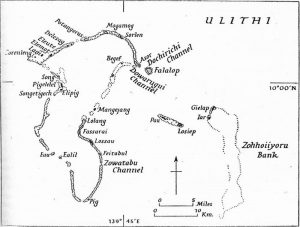- Author
- A.N. Other
- Subjects
- WWII operations, History - WW2
- Tags
-
- RAN Ships
- None noted.
- Publication
- September 2015 edition of the Naval Historical Review (all rights reserved)
By Noel Burgess
We might be forgiven for not knowing much about the United States Naval Base at Ulithi, as for a long time its existence was kept secret, but for a period it was one of the world’s largest naval facilities.
Early in WWII allied forces driven from South East Asia established safe havens in Australia and New Caledonia where they consolidated and replenished before re-engaging the enemy in the waters and islands of the southwest Pacific. Gradual advances were made through New Guinea leading to the recovery of the Admiralty Islands, the largest of which is Manus. Manus with its significant anchorage quickly became a forward base for the United States Navy with replenishment and maintenance facilities seemingly established overnight. This formed part of a strategic program of mobile service support forces that made it possible for the USN to move towards Japan in great leaps instead of taking the slow and costly alternatives of capturing and securing land bases.
Manus was however south of the equator and a further staging post was required closer to the Japanese mainland. By good fortune the Japanese had been expelled from the Caroline Islands which contained another extensive anchorage suitable for a large fleet. The Carolines are at approximately ten degrees north of the equator, some 720 nautical miles or 1,330 kms north of Manus. Manus was then largely left to become a temporary home and staging post of the British Pacific Fleet.


Caroline Islands
The Caroline Islands were discovered by the Portuguese navigator Diego da Rocha in 1526. To the Spaniards, who established a mission in 1731, they were known as Islas de los Garbanzos (Chickpea Islands). As part of its colonial expansion Germany purchased the islands in 1899 and retained them until the loss of their Pacific possessions early in WWI. Their colonies to the north of the equator were garrisoned by the Japanese and those to the south by Australia and New Zealand.
The Japanese built an airstrip at Ulithi, which is about 1,130 nm or 2,100 kms south of Tokyo, and there were also radio and metrological stations. By 1944 Japanese forces withdrew from the Carolines. They were then surveyed by USS Sumner who reported that the lagoon of Ulithi which is 36 km long and up to 24 km wide with depths averaging 20 fathoms was capable of holding a fleet of 700 vessels. When the USN arrived to an unopposed landing they found resident about 400 native inhabitants and surprisingly three Japanese soldiers. The locals were moved to one island to allow consolidation of naval facilities.
With immense energy the United States military machine started arriving on 23 September 1944. First came the US Army 81st Division followed by a Battalion of Seabee’s to begin construction of facilities, particularly fresh water supplies. Within a month a workforce of 6,000 started work on airstrips and shore facilities. Pontoon piers were sunk into the seabed providing safe moorings for supply ships to provide fuel, ammunition and provisions and floating docks for repairs and maintenance. Recreation facilities were also provided. Some of the support vessels were not self propelled but towed here as floating mobile warehouses.
In March 1945, 15 battleships, 29 aircraft carriers, 23 cruisers, 106 destroyers and a train of tankers and supply ships sailed from Ulithi for the Philippines and the great amphibious landing at Okinawa. As the floating base moved on Ulithi, which had a temporary population equal to a medium sized city, and had been master of half the world for seven months, shrank to little more than a tanker depot. Once again, it quickly became a quiet, lonely atoll.




